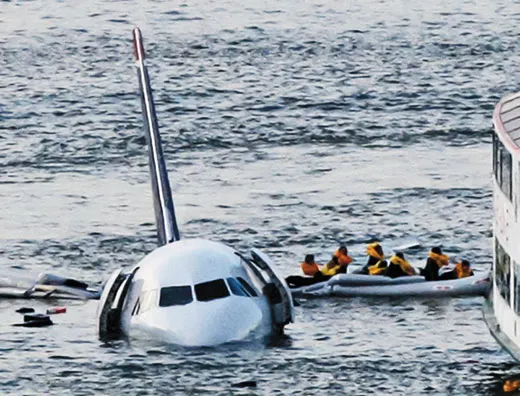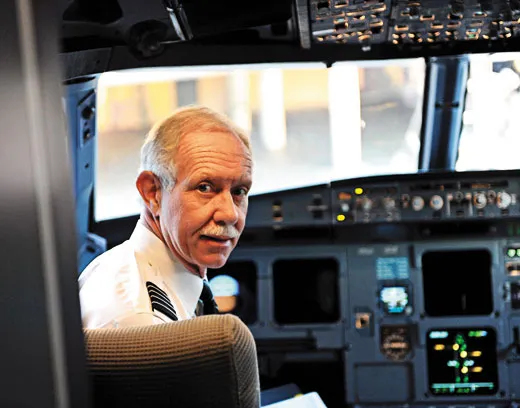Q and A: Capt. Chesley “Sully” Sullenberger
The pilot of US Airways Flight 1549 talks about that fateful day, being a pilot and his future
/https://tf-cmsv2-smithsonianmag-media.s3.amazonaws.com/filer/QA-Sully-Sullenberger-631.jpg)
In recognition of his heralded emergency landing on the Hudson River on January 15, 2009, Capt. Chesley “Sully” Sullenberger and the crew of US Airways Flight 1549 were awarded the National Air and Space Museum’s highest honor: the 2010 Current Achievement Trophy. He spoke with the magazine’s Megan Gambino.
What can other pilots learn from your experience?
One of the things I encourage other pilots to think about is that—out of a 43-year career—my entire life is being judged on the basis of those 3 minutes and 28 seconds. We never know which flight will test us. So it’s incumbent on each of us to be vigilant and avoid complacency. I had gotten to a point late in my career when I thought that test would never happen to me. I was wrong.
What is your definition of a hero?
My wife actually looked it up in the dictionary. We decided between ourselves that it describes someone who chooses to put himself at risk to save another. That didn’t quite fit my situation, which was thrust upon me suddenly. Certainly, my crew and I were up to the task. But I’m not sure it quite crosses the threshold of heroism. I think the idea of a hero is important. But sometimes in our culture we overuse the word, and by overusing it we diminish it.
In general, do you think the public takes for granted the challenges confronting airline pilots?
We have gotten so used to the convenience and safety of flying that we tend to overlook two things. First, flying is a relatively new human endeavor. Second, people forget that what we’re really doing, ultimately, is pushing an aluminum or a composite tube through the upper reaches of the troposphere or the lower regions of the stratosphere at 80 percent of the speed of sound in a hostile environment—and we must return it safely to the surface every single time. If it were easy, anybody—everybody—could do it.
What has been your most unexpected insight?
One of the biggest surprises is that—unlike so many stories that fade with the end of the news cycle—this one simply hasn’t. I guess the lesson learned is about the power of certain events to touch and inspire people and renew their faith in humanity and give them hope.
The birds that hit Flight 1549 were identified as Canada geese at the Smithsonian’s Bird Identification Lab. What, if anything, would you like to tell Smithsonian scientists about bird strike hazards?
I want to thank them for having the expertise to be able to identify not only the species but, I think, by using DNA, they were able to identify how many individual birds were ingested into the engines. So that was a great help to the investigation. I’m sure that there are many people who are looking at the problems of bird strikes from a lot of different points of view, in terms of making the airport environment safer, in terms of aircraft design and certification standards and in terms of the operational procedures we might be able to implement to reduce the risk. I encourage them to keep on learning more about that. I think it’s an entirely worthwhile effort.
If you could have one artifact from your career be put on display at the National Air and Space Museum, what would it be, and why?
I would choose my Jeppesen route manual binder, still full of charts, and somewhat worse for wear, that has taped inside the front cover a fortune I got at a Chinese restaurant in the late 1980s. It reads simply, “A delay is better than a disaster.” I thought it was good advice then, and I have kept it in my binder ever since – including on flight 1549. I believe that we in this industry owe it to our passengers always to insist on the highest professional standards and to do for them the very best that we know how to do. This means having the integrity and courage to reject the merely expedient and the barely adequate as being – quite frankly – not good enough.
You have retired. What’s next?
Well, it was a retirement only from one job. I had a 30-year career at the airline. But I still have lots of things on my plate. I’m writing a second book for my publisher. I’m doing a lot of speaking engagements around the world, as well as some safety work and consulting. So it’s still a very busy time, and I am actively looking for ways to try to make a difference and use this notoriety for good in every way that I can for as long as I can.
/https://tf-cmsv2-smithsonianmag-media.s3.amazonaws.com/accounts/headshot/megan.png)


/https://tf-cmsv2-smithsonianmag-media.s3.amazonaws.com/accounts/headshot/megan.png)